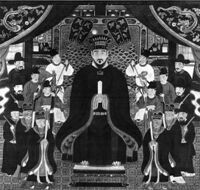Difference between revisions of "Sho Genko"
From SamuraiWiki
Jump to navigationJump to search| (2 intermediate revisions by the same user not shown) | |||
| Line 1: | Line 1: | ||
[[Image:King Sho Nei.jpg|right|thumb|200px|A posthumous portrait of King [[Sho Nei|Shô Nei]] (r. 1587-1620), painted by Shô Genko in 1796.]] | [[Image:King Sho Nei.jpg|right|thumb|200px|A posthumous portrait of King [[Sho Nei|Shô Nei]] (r. 1587-1620), painted by Shô Genko in 1796.]] | ||
| − | *''Born: [[1784]]'' | + | *''Born: [[1784]]/11/13'' |
| − | *''Died: [[1841]]'' | + | *''Died: [[1841]]/12/9'' |
| − | *''Other Names'': 小橋川朝安 ''(Kobashigawa | + | *''Other Names'': 小橋川朝安 ''(Kobashigawa Chouan)'' |
*''Japanese'': [[向]]元瑚 ''(Shou Genko)'' | *''Japanese'': [[向]]元瑚 ''(Shou Genko)'' | ||
| − | Shô Genko, also known by the [[Okinawan name|Japanese-style name]] Kobashigawa | + | Shô Genko, also known by the [[Okinawan name|Japanese-style name]] Kobashigawa Chôan, was a painter who served under five successive kings of [[Kingdom of Ryukyu|Ryûkyû]]. The first painter to ever be elevated to the rank of ''ueekata'',<ref name=junko>Junko Kobayashi, "The Demise of Ryukyuan Painting," Okinawan Art in its Regional Context symposium, University of East Anglia, Norwich, 10 Oct 2019.</ref> he is best known for his [[ogo-e|posthumous royal portraits]] of multiple kings of the kingdom, but is said to have also been a master of, in particular, [[bird-and-flower painting]], and paintings of tigers. |
| + | |||
| + | Genko was born in [[Shuri]], and began teaching Chinese-style painting in [[Kagoshima]] in [[1801]].<ref name=junko/> | ||
| + | |||
| + | He was elevated to the [[Ryukyuan court ranks|rank]] of ''ueekata'' in [[1843]].<ref>''Okinawa bijutsu zenshû'' vol 6, Okinawa Times (1989), 65.</ref> | ||
Many of his works were stored at his former home for many years, but most were destroyed in the 1945 battle of Okinawa. | Many of his works were stored at his former home for many years, but most were destroyed in the 1945 battle of Okinawa. | ||
| Line 11: | Line 15: | ||
==References== | ==References== | ||
*"[http://ryukyushimpo.jp/news/storyid-41733-storytopic-121.html Shô Genko]." ''Okinawa konpakuto jiten'' (沖縄コンパクト事典, "Okinawa Compact Encyclopedia"). Ryukyu Shimpo. 1 March 2003. Accessed 22 February 2010. | *"[http://ryukyushimpo.jp/news/storyid-41733-storytopic-121.html Shô Genko]." ''Okinawa konpakuto jiten'' (沖縄コンパクト事典, "Okinawa Compact Encyclopedia"). Ryukyu Shimpo. 1 March 2003. Accessed 22 February 2010. | ||
| + | <references/> | ||
[[Category:Artists and Artisans]] | [[Category:Artists and Artisans]] | ||
[[Category:Ryukyu]] | [[Category:Ryukyu]] | ||
[[Category:Edo Period]] | [[Category:Edo Period]] | ||
| + | [[Category:Nobility]] | ||
Latest revision as of 02:05, 11 October 2024

A posthumous portrait of King Shô Nei (r. 1587-1620), painted by Shô Genko in 1796.
Shô Genko, also known by the Japanese-style name Kobashigawa Chôan, was a painter who served under five successive kings of Ryûkyû. The first painter to ever be elevated to the rank of ueekata,[1] he is best known for his posthumous royal portraits of multiple kings of the kingdom, but is said to have also been a master of, in particular, bird-and-flower painting, and paintings of tigers.
Genko was born in Shuri, and began teaching Chinese-style painting in Kagoshima in 1801.[1]
He was elevated to the rank of ueekata in 1843.[2]
Many of his works were stored at his former home for many years, but most were destroyed in the 1945 battle of Okinawa.
References
- "Shô Genko." Okinawa konpakuto jiten (沖縄コンパクト事典, "Okinawa Compact Encyclopedia"). Ryukyu Shimpo. 1 March 2003. Accessed 22 February 2010.